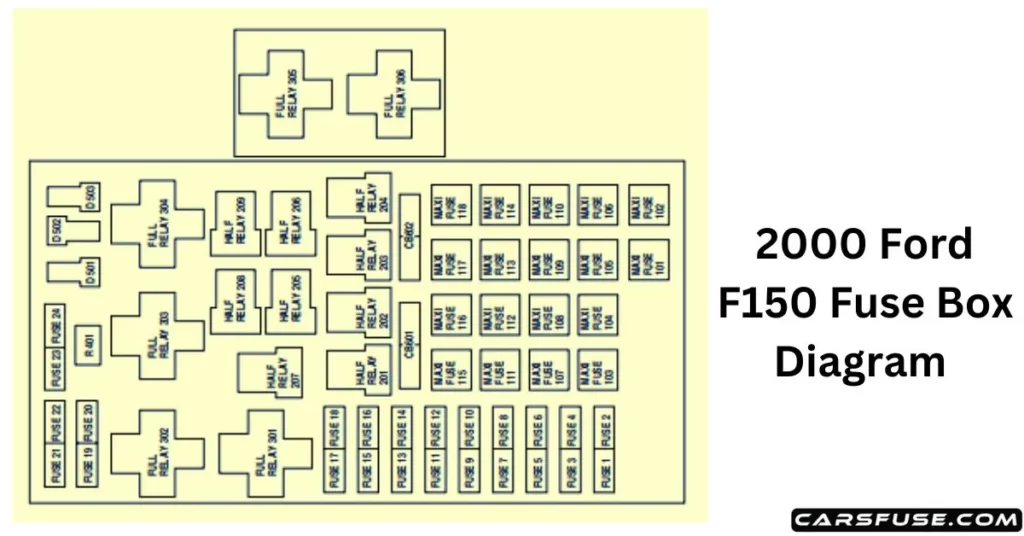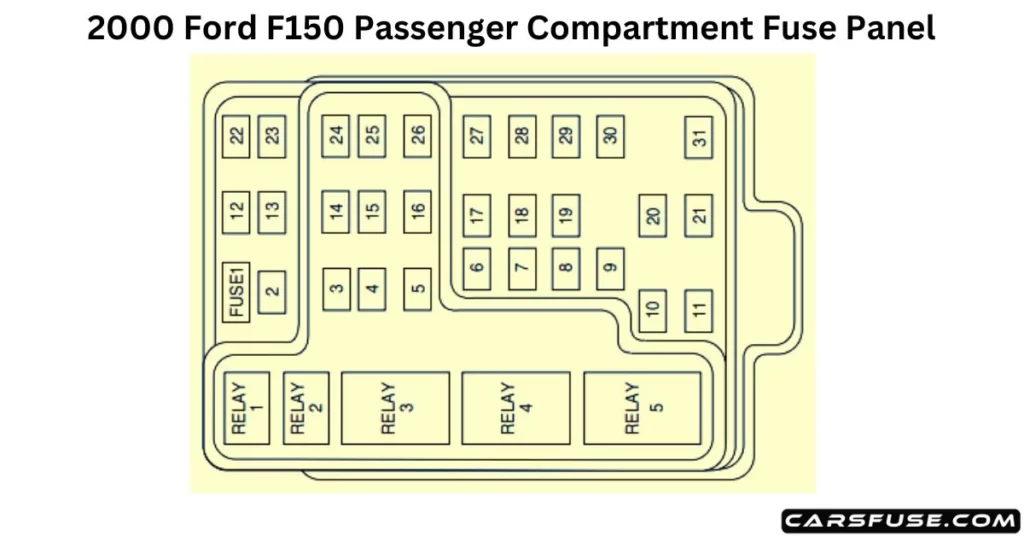In this article, we’ll take a close look at the 2000 Ford F150 fuse box diagram. We’ll explain what each fuse does so you can understand your electrical system better and use it more confidently.
Note: All information contained in this Quick Reference Guide was accurate at the time of duplication. For detailed operating and safety information, please consult your Owner’s Manual.
Table of Contents
Important: Always disconnect the battery before servicing high-current fuses. To reduce the risk of electrical shock, always replace the cover with the power distribution box before reconnecting the battery or refilling fluid reservoirs. Always replace a fuse with one that has the specified amperage rating. Using a fuse with a higher amperage rating can cause severe wire damage and could start a fire.
2000 Ford F150 Power Distribution Box Diagram
The power distribution box, which houses high-current fuses, is situated in the engine compartment of your vehicle. These fuses play a crucial role in safeguarding the main electrical systems from overloads, ensuring their proper functioning. The high-current fuses within the power distribution box are coded using a specific system. This coding scheme helps identify and differentiate the various fuses.
Note: In the event that you need to disconnect and reconnect the battery, it's important to note that certain features may require resetting. This step is necessary to restore their functionality.

*Mini fuses / **Maxi fuses
| Fuse/Relay Location | Fuse AmpRating | Power Distribution Box Description |
| 1 | 20A * | PowerPoint |
| 2 | 30A* | Powertrain Control Module |
| 3 | 30A* | Headlamps/Autolamps |
| 4 | — | Not Used |
| 5 | 20A* | Trailer Tow Backup/Park Lamps |
| 6 | 15A* | Parklamps/Autolamps, Passenger Fuse Panel Feed Fuse #18 |
| 7 | 20A* | Horn |
| 8 | 15A* | Power Door Locks |
| 9 | 15A* | Daytime Running Lamps (DRL), Fog Lamps |
| 10 | 20A* | Fuel Pump |
| 11 | 20A* | Alternator Field |
| 12 | 20A* | Rear Auxiliary PowerPoint |
| 13 | 15A* | A/C Clutch |
| 14 | — | Not Used |
| 15 | — | Not Used |
| 16 | — | Not Used |
| 17 | — | Not Used |
| 18 | 15A* | Powertrain Control Module, FuelInjectors, Fuel Pump Relay, Idle AirControl, Mass Air Flow Sensor |
| 19 | 10A* | Trailer Tow Stop and Right Turn Lamp |
| 20 | 10A* | Trailer Tow Stop and Left Turn Lamp |
| 21 | — | Not Used |
| 22 | — | Not Used |
| 23 | 15A* | HEGO Sensor, Canister Vent, Automatic Transmission, CMS Sensor |
| 24 | — | Not Used |
| 101 | 30A** | Trailer Tow Battery Charge |
| 102 | 50/20A** | Four Wheel Antilock BrakeModule/Rear Wheel Antilock BrakeModule |
| 103 | 50A** | Junction Block Battery Feed |
| 104 | 30A** | 4×4 Shift Motor & Clutch |
| 105 | 40A** | Climate Control Front Blower |
| 106 | 20A** | Inter Cooler Pump (Lightning only) |
| 107 | — | Not Used |
| 108 | 30A** | Trailer Tow Electric Brake |
| 109 | — | Not Used |
| 110 | 30A** | Power Windows |
| 111 | 40A** | Ignition Switch Battery Feed (Start and Run Circuits) |
| 112 | 30A** | Drivers Power Seat, Adjustable Pedals |
| 113 | 40A** | Ignition Switch Battery Feed (Run and Accessory Circuits) |
| 114 | — | Not Used |
| 115 | 20A** | Power Door Locks (SuperCrew only) |
| 116 | — | Not Used |
| 117 | — | Not Used |
| 118 | — | Not Used |
| 201 | — | Trailer Tow Park Lamp Relay |
| 202 | — | Front Wiper Run/Park Relay |
| 203 | — | Trailer Tow Backup Lamp Relay |
| 204 | — | A/C Clutch Relay |
| 205 | — | Horn Relay |
| 206 | — | Fog Lamp Relay |
| 207 | — | Front Washer Pump Relay |
| 208 | — | Inter Cooler Pump Relay (Lightning only) |
| 209 | — | Front Wiper Hi/Lo Relay |
| 301 | — | Fuel Pump Relay |
| 302 | — | Trailer Tow Battery Charge Relay |
| 303 | — | Not Used |
| 304 | — | Powertrain Control Module Relay |
| 305 | — | Fuel Pump Hi/Lo Relay (Lightning only) |
| 306 | — | Inertia Switch Relay (Lightning only) |
| 401 | — | Not Used |
| 501 | — | Powertrain Control Module Diode |
| 502 | — | A/C Compressor Diode |
| 503 | — | Not Used |
| 601 | CB | Power Windows, Moonroof (SuperCrew only) |
| 602 | — | Not Used |
2000 Ford F150 Passenger Compartment Fuse Panel
The fuse panel is located below and to the left of the steering wheel by the brake pedal. Remove the panel cover to access the fuses.

| Fuse/Relay Location | Fuse AmpRating | Passenger Compartment Fuse Panel Description |
| 1 | 15A | Audio |
| 2 | 5A | Powertrain Control Module (PCM), Cluster |
| 3 | 20A | Cigar Lighter, OBD-II Scan Tool Connector |
| 4 | 5A | Remote Entry Module, Mirrors |
| 5 | 15A | Speed Control Module, ReverseLamp, Climate Mode Switch, Daytime Running Lamp Relay |
| 6 | 5A | Cluster, Brake Shift Interlock Solenoid, GEM Module |
| 7 | — | Not Used |
| 8 | 5A | Radio, Remote Entry Module, GEM Module |
| 9 | — | Not Used |
| 10 | — | Not Used |
| 11 | 30A | Front Washer Pump Relay, WiperRun/Park Relay, Wiper Hi/LO Relay, Windshield Wiper Motor |
| 12 | — | Not Used |
| 13 | 20A | Stop Lamp Switch (Lamps), Turn/Hazard Flasher, Speed ControlModule |
| 14 | 15A | Battery Saver Relay, Interior LampRelay, Accessory Delay Relay (PowerWindows) |
| 15 | 5A | Stop Lamp Switch, (Speed Control, Brake Shift Interlock, ABS, PCMModule Inputs), GEM Module, RABSTest Connector |
| 16 | 20A | Headlamps (Hi Beams), Cluster (Hi Beam Indicator) |
| 17 | — | Not Used |
| 18 | 5A | Instrument Illumination (Dimmer Switch Power) |
| 19 | — | Not Used |
| 20 | 5A | Audio, GEM (or CTM) Module, Powertrain Control Module (PCM), |
| 21 | 15A | Starter Relay, Clutch Switch, Fuse 20 |
| 22 | 10A | Air Bag Module, Passenger Airbag Deactivation Module, Climate ModeSwitch (Blower Relay) |
| 23 | 10A | Trailer Tow Battery Charge Relay, Turn/Hazard Flasher, 4×4 Solenoids,4×4 Relays, Overhead Console, 4Wheel Anti-Lock Brake System(4WABS) Module |
| 24 | — | Not Used |
| 25 | — | Not Used |
| 26 | 10A | Right Side Low Beam Headlamp |
| 27 | 5A | Foglamp Relay and FoglampIndicator |
| 28 | 10A | Left Side Low Beam Headlamp |
| 29 | 5A | Autolamp Module, Transmission Overdrive Control Switch |
| 30 | 30A | Passive Anti Theft Transceiver, Cluster, Ignition Coils, PowertrainControl Module Relay |
| 31 | — | Not Used |
| Relay 1 | — | Interior Lamp Relay |
| Relay 2 | — | Battery Saver Relay |
| Relay 3 | — | Not Used |
| Relay 4 | — | One Touch Down Window Relay |
| Relay 5 | — | ACC Delay Relay |
2000 Ford F150 Standard fuse amperage rating and color
| Fuse Rating | Mini Fuses | Standard Fuses | Maxi Fuses | Cartridge Maxi Fuses | Fuse Link Cartridge |
| 2A | Grey | Grey | — | — | — |
| 3A | Violet | Violet | — | — | — |
| 4A | Pink | Pink | — | — | — |
| 5A | Tan | Tan | — | — | — |
| 7.5A | Brown | Brown | — | — | — |
| 10A | Red | Red | — | — | — |
| 15A | Blue | Blue | — | — | — |
| 20A | Yellow | Yellow | Yellow | Blue | Blue |
| 25A | Natural | Natural | — | — | — |
| 30A | Green | Green | Green | Pink | Pink |
| 40A | — | — | Orange | Green | Green |
| 50A | — | — | Red | Red | Red |
| 60A | — | — | Blue | — | Yellow |
| 70A | — | — | Tan | — | Brown |
| 80A | — | — | Natural | — | Black |
Tom Smith is a passionate car mechanic and automotive enthusiast, specializing in the intricate world of car fuse boxes. With years of hands-on experience under the hood, he has earned a reputation as a reliable expert in his field. As the founder and content creator of the popular blog website 'carsfuse.com,' Tom has dedicated himself to sharing his extensive knowledge of car fuse boxes and electrical systems with the world.



Hello Tom
O have a 2000 f150 that has stopped charging the battery the gauge shows 14 volts when i reeve it the gauge will shows it charging then to neg when idol drops to negative
. I have replaced the alternator and had it tested and the regulator test is good
its the v8 trittion excab I have had it a while 278K miles and have not bee able to figure it out all fuses are good this is the only issue what can you share with me posss causes
Hello Willy,
I have some recommendations for you.
Battery Connections: Make sure to inspect the battery terminals thoroughly for any signs of corrosion or loose fittings. A poor connection could hinder the alternator’s ability to charge the battery effectively. Clean the terminals and ensure they are securely tightened.
Wiring Concerns: Examine the wiring between the alternator and the battery for any damage or faults. Look out for wires that are frayed, burnt, or corroded within the charging circuit. While a visual inspection is useful, using a multimeter can provide a more accurate diagnosis of continuity and voltage along the circuit.
Voltage Regulator Issues:
Although the alternator regulator may have tested fine, there’s still a possibility of malfunction under specific circumstances. A defective voltage regulator within the alternator itself can lead to erratic charging behavior.
Other Potential Causes: Consider less common causes such as a failing battery (even if it shows 14V when revved), a faulty ground connection, or a malfunctioning instrument cluster causing inaccurate gauge readings.
Next Steps: Measure Voltage at Different Points: Utilize a multimeter to measure the voltage directly at the alternator output post while the engine is running, as well as at the battery terminals. This can help pinpoint where any voltage drop is occurring.
Check Battery Health: Even if the battery displays 14V, it’s prudent to have a load test conducted at a parts store to assess its overall health. A weak battery may struggle to maintain a charge effectively.
Ground Connections: Ensure all ground connections, particularly those relevant to the charging system, are clean and securely fastened.